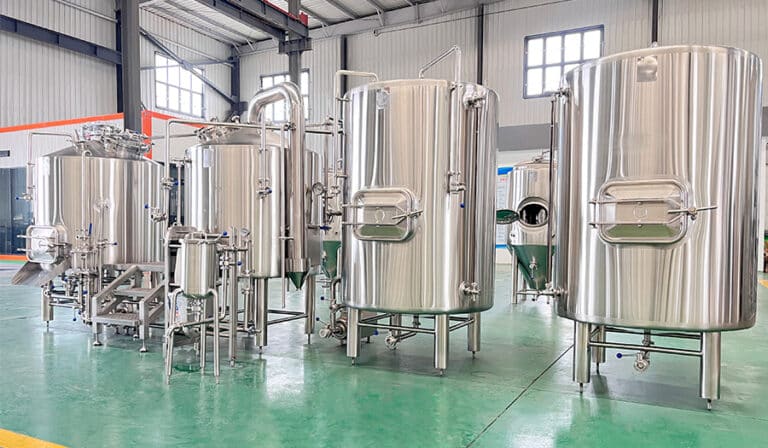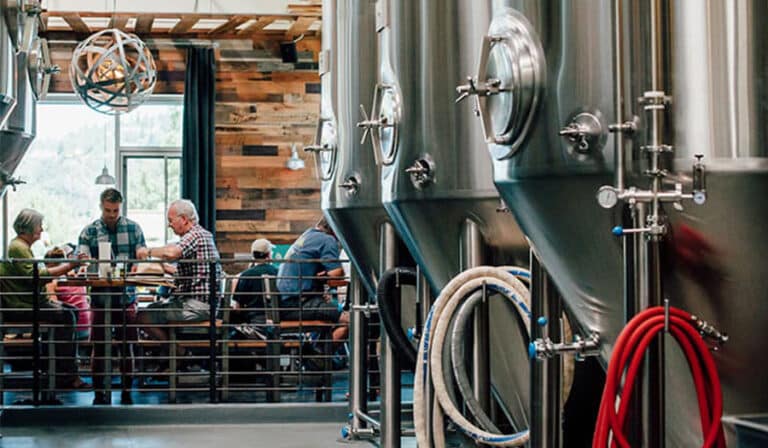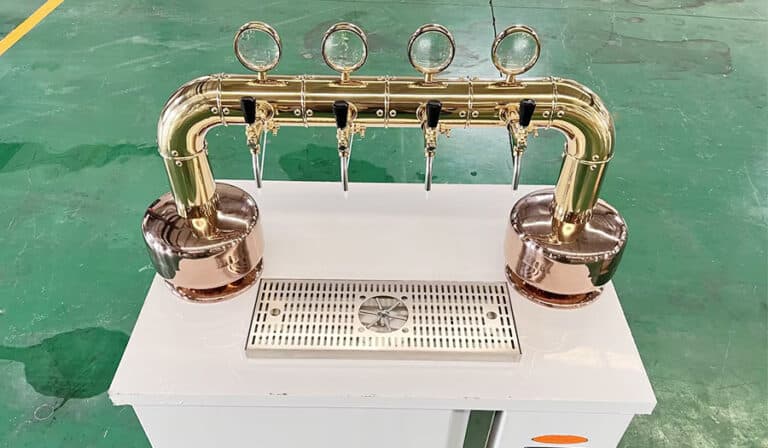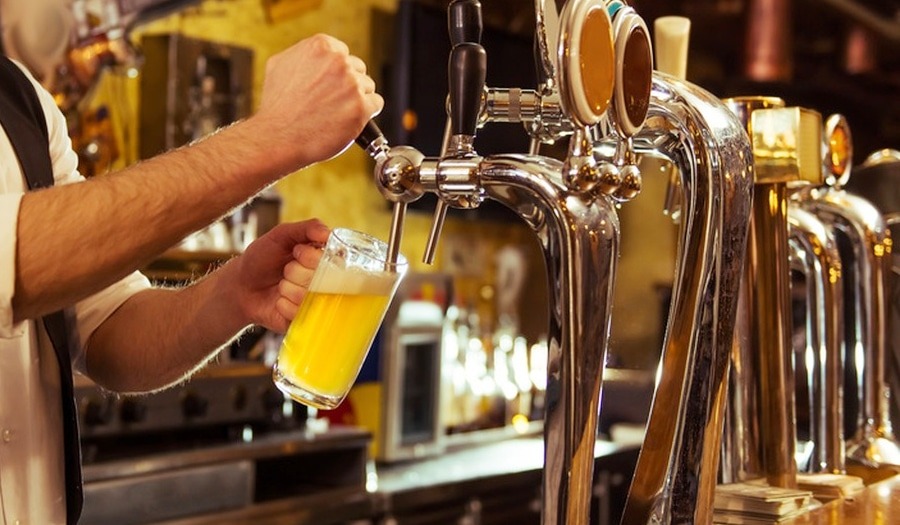신선한 맥주의 독특한 맛과 신선한 향은 많은 소비자를 매료시킵니다. 신선한 맥주를 선택할 때는 특정 양조 기술 외에도 신선한 맥주의 품질이 중요합니다. 양조 장비. 이 가이드는 초보자와 애호가들이 양조 산업을 더 잘 이해할 수 있도록 신선한 양조에 필요한 장비에 대해 자세히 설명합니다.
신선한 맥주란 무엇인가요?
"생맥주" 또는 "신선한 맥주"라고도 하는 생맥주는 고온에서 양조하거나 장기간 보관하지 않은 맥주의 일종입니다. 일반적으로 양조 직후에 소비됩니다. 전통적인 산업용 맥주와 비교하여 신선한 맥주는 다음과 같은 특징이 있습니다:
- 풍부한 맛: 생맥주는 일반적으로 짧은 시간 동안 양조한 후 더 부드럽고 풍부한 맛을 냅니다.
- 낮은 알코올 함량: 많은 신선한 맥주는 알코올 도수가 비교적 낮기 때문에 다양한 상황에서 마시기 적합합니다.
- 천연 재료: 신선한 맥주는 일반적으로 방부제를 첨가하지 않고 천연 원료를 사용하며 맥아, 홉, 물, 효모 본연의 풍미를 유지합니다.
- 다양한 맛: 신선한 원료를 사용하기 때문에 신선한 맥주의 풍미는 계절의 변화, 사용된 재료의 차이 및 기타 요인에 따라 매우 다양한 경우가 많습니다.
- 양조 방법: 대부분의 신선한 맥주는 소규모 양조장이나 수제 맥주 양조장에서 생산되며, 대부분 전통적인 수작업 양조 방식을 사용하기 때문에 일반적으로 맛과 질감 면에서 더 개인화되어 있습니다.
- 지역 유통: 신선한 맥주의 유통기한은 상대적으로 짧기 때문에 주로 현지 시장에서 한정된 수량으로 판매됩니다.

생맥주 양조 장비 개요
신선한 맥주의 생산 과정에는 여러 단계가 포함되며 각 단계마다 특별한 장비가 필요합니다. 전체 양조 과정은 원료 준비, 매시, 발효, 여과, 병입 및 보관 등 여러 단계로 나눌 수 있습니다. 각 단계에는 효율적이고 위생적인 양조 과정을 달성하기 위해 해당 장비가 갖추어져 있습니다.
파쇄 장비
신선한 맥주 만들기. 첫 번째 단계는 주로 맥아, 홉, 물과 같은 원재료를 준비하는 것입니다. 이 단계에서는 장비가 매우 중요합니다. 분쇄 장비를 통해 맥아를 적절한 입자로 분쇄할 수 있습니다. 이 공정의 목적은 맥아의 모양을 개선하여 후속 매시 공정이 더 매끄럽게 진행될 수 있도록 하는 것입니다. 일반적인 분쇄 장비에는 싱글 롤 크러셔와 더블 롤 크러셔가 있습니다. 싱글 롤 크러셔는 소규모 와이너리에 적합하며, 더블 롤 크러셔는 대규모 와이너리에 적합합니다.
청소 장비
청소도 무시할 수 없는 단계입니다. 청소 장비는 일반적으로 맥아 원료 및 기타 원료를 사용하기 전에 교체하고 청소할 필요가 없도록 물 세척 또는 청소 브러시의 조합을 채택합니다.
매시 포트
매시는 신선한 맥주 양조의 핵심 단계 중 하나로, 맥아즙을 발효 가능한 설탕으로 전환하는 과정입니다. 매시 포트는 이 단계를 위한 특수 장비로, 일반적으로 스테인리스 스틸로 만들어져 청소와 관리가 쉽습니다.
매시 포트의 작동 원리는 맥아를 뜨거운 물과 섞어 분쇄하고, 적절한 온도와 시간으로 반응시켜 새싹 주스를 만드는 것입니다. 이 과정에서 온도 조절은 매우 중요하며, 온도에 따라 매시 효율과 최종 특성에 영향을 미칩니다.
끓는 냄비
맥아 즙의 공식에 따르면 당화 된 맥아 즙은 박테리아를 죽이고 아일랜드 와인의 향을 내기 위해 끓여야합니다. 끓는 냄비에는 일반적으로 강력한 가열 시스템과 교반 장치가 장착되어 냄비의 온도를 균일하게 유지하고 끓는 과정을 가속화하며 끓는 과정에서 홉이 추가됩니다. 홉은 쓴맛을 제공할 뿐만 아니라 맥주의 화학적 향과 안정성을 제공합니다. 따라서 끓는 냄비의 디자인은 일반적으로 편리한 맥주 추가 기능을 고려합니다.
냉각기
끓인 맥아즙은 후속 발효 과정을 원활하게 진행하기 위해 빠르게 식혀야 합니다. 이 장비는 이러한 목적을 달성하기 위한 장치로, 일반적으로 플레이트 쿨러 또는 튜브 쿨러를 사용합니다. 쿨러의 작동 원리는 냉수와 온수의 열 교환을 통해 맥아즙 온도를 최저 발효 온도로 빠르게 낮추는 것입니다.
발효 탱크
The 발효 탱크 는 신선한 맥주 양조의 마지막 핵심 장비 중 하나입니다. 양조 후 맥즙은 발효 탱크로 옮겨져 설탕이 알코올로 전환됩니다. 발효 탱크의 재질은 일반적으로 세척을 용이하게 하고 위생을 보장하기 위해 스테인리스 스틸을 사용합니다. 발효 탱크 설계는 압력과 온도의 결정을 보장하므로 일반적으로 제어 시스템과 압력 게이지가 장착되어 있습니다. 배럴이 일반적인 선택이지만 양조업자들은 효율적이고 효모 침전물을 처리하기 쉽기 때문에 스테인리스 스틸 발효 탱크를 선호합니다.
여과 장비
발효가 끝나면 맥주에 폐수 및 기타 부유 물질이 남아있을 수 있으며, 이를 여과 장비로 처리해야 합니다. 필터는 다양한 유형의 필터를 사용하여 폐수를 효과적으로 제거하고 맥주의 폐수 및 투명성을 보장합니다.

핵심 양조 장비:
|
유형 |
기능 |
|
양조 주전자 |
매시 가열 및 맥아즙 끓이기 |
|
마쉬툰 |
설탕 추출을 위해 뜨거운 물에 곡물을 담그기 |
|
뜨거운 주류 탱크 |
양조용 물 가열 |
|
맥아즙 냉각기 |
발효 전 끓인 맥아즙을 빠르게 식히기 |
|
발효기 |
맥즙을 맥주로 발효시키기 |
|
에어락 |
공기 중 감염을 차단하면서 CO2 배출 허용 |
|
보틀링 버킷 |
병입 전 맥주와 프라이밍 설탕 혼합하기 |
|
병 |
탄산 맥주 보관 |
|
맥주통 |
생맥주 제공 |
|
랙 장비 |
용기 간 맥주 옮기기 |
|
온도계 |
매시 및 끓임 온도 모니터링 |
|
비중계 |
맥주의 비중 측정 |
|
소독제 |
장비 세척 및 소독 |
생맥주 양조 과정
- 소독: 맥주 변질과 불쾌한 풍미를 최소화하려면 양조를 시작하기 전에 작업 공간을 철저히 청소하고 소독해야 합니다.
- 매시: "매시"라는 용어는 곡물의 효소가 복잡한 전분을 알코올로 전환할 수 있는 당분으로 전환하는 과정을 설명합니다. 곡물은 일반적으로 149°F~154°F(또는 65°C~68°C) 사이의 뜨거운 물에 1시간 동안 '매시 툰'에 담급니다. 곡물이 완전히 으깬 후에는 신선한 따뜻한 물로 '헹구어' 모든 당분을 추출합니다.
- 끓이기: 이 과정은 맥아즙을 농축하고 살균하며 최종 맥아즙 성분을 크게 변화시켜 완성된 맥주의 풍미, 바디감, 식감에 영향을 미칩니다. 맛있는 홉도 여기에 추가됩니다.
- 냉각: 끓인 후 맥즙은 매우 뜨거우므로 효모를 첨가하기 전에 식혀서 발효 과정을 시작해야 합니다. 열 교환기는 정화 된 맥즙을 발효기로 전달합니다. 맥즙은 양조 중인 맥주의 종류에 따라 열교환기를 통과하면서 빠르게 냉각됩니다.
- 발효: 효모는 맥아당을 알코올과 이산화탄소로 전환합니다. 맥아당 발효가 완료되면 효모는 가라앉아 뭉쳐집니다. 생맥주는 사용하는 효모와 맥아즙을 만드는 방법에 따라 상면 발효 또는 하면 발효가 가능합니다.
- 병입: 병은 반드시 살균 및 세척해야 하며, 병입 후에는 각 병을 서늘하고 어두운 곳에 최소 2주 동안 보관해야 합니다.

신선한 맥주 양조 장비는 어떻게 선택하나요?
- 양조의 목적과 규모를 명확하게 정의하세요: 필요에 따라 장비의 종류와 사양이 결정됩니다. 소규모 가정용 양조 장비는 일반적으로 크기가 작고 작동이 간단하며 비교적 저렴한 반면, 상업용은 생산 요구 사항을 충족하기 위해 더 크고 전문적인 장비가 필요합니다.
- 온도 조절: 효모 균주마다 정통 맥주를 양조하려면 특정 발효 온도가 필요합니다. 온도 제어식 발효실 가열 스트립이나 늪 냉각기와 같은 기술을 사용하여 이상적인 온도를 유지할 수 있습니다.
- 장비 재료: 맥주 양조 장비의 재질은 맥주의 품질과 장비의 수명과 직접적인 관련이 있습니다. 스테인리스 스틸은 내식성, 세척 용이성, 고강도 등의 장점이 있습니다. 시중에 나와 있는 맥주 양조 장비의 가장 일반적인 소재입니다.
- 정확성과 일관성: 매시 온도부터 발효 조건까지, 양조의 모든 단계에서 정확성은 중요합니다. 온도계, 계측기, 정밀 밸브가 내장된 장비를 선택하세요.
- 자동화 및 제어: 제어 시스템은 추출 공정을 관리하여 품질과 일관성을 보장할 수 있습니다. 수동, 반자동 또는 자동 제어 시스템을 선택할 수 있습니다.
- 브랜드 및 애프터 서비스: 잘 알려진 브랜드의 맥주 양조 장비를 선택하면 장비의 품질과 성능을 보장할 수 있습니다. 또한 장비 설치, 시운전, 유지 보수 등과 같은 애프터 서비스도 이해해야 합니다. 좋은 애프터 서비스는 장비의 문제를 즉시 해결할 수 있습니다.
자주 묻는 질문
신선한 맥주란 무엇인가요?
생맥주는 일반적으로 장기간 보관하거나 숙성하지 않고 방금 양조한 신선한 맥주를 말하며, 풍미가 더 풍부하고 맛이 더 신선합니다.
맥주를 양조하는 데 시간이 얼마나 걸리나요?
구체적인 기간은 맥주의 종류와 양조 방법에 따라 달라질 수 있습니다. 예를 들어, 일부 맥주(예: 라거)는 발효 및 컨디셔닝에 몇 주가 걸리는 반면, 다른 맥주(예: 몰트 맥주)는 마시는 데 일주일밖에 걸리지 않을 수 있습니다.
추출 장비의 용량은 어떻게 선택하나요?
장비의 용량은 예상 생산량에 따라 선택해야 합니다. 예를 들어 하루에 100리터의 맥주를 생산할 계획이라면 이 생산량에 적합한 매시 툰과 발효 탱크를 선택해야 합니다.
양조 장비에는 어떤 재료를 선택해야 하나요?
스테인리스 스틸은 부식에 강하고 세척이 용이하며 위생 상태를 양호하게 유지할 수 있으므로 스테인리스 스틸로 만든 장비를 선택하는 것이 좋습니다.




